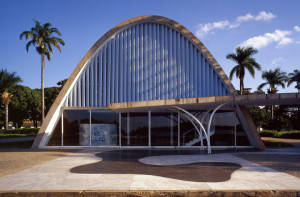Pavilion of Brazil at the 14th International Architecture Exhibition – la Biennale di Venezia
Commissioner: Luis Terepins, President of the Bienal de São Paulo Foundation
Curator: André Aranha Corrêa do Lago
Exhibition title: Brazil: Modernism as Tradition
Venue: Brazilian Pavilion
Address: Giardini Castello, Padiglione Brasile, 30122 Venice, Italy
Date: June 7 to November 23, 2014
Invited by the Bienal de São Paulo Foundation, the diplomat and architecture critic André Aranha Corrêa do Lago agreed to curate the Brazilian contribution to the exhibition. “Brazil is one of the countries that absorbed the precepts of modern architecture in the most interesting ways, and this helped strengthen the national identity. Unlike other countries, which, over the centuries, developed a typical national architecture—recognizable in caricatural form to other peoples—what we call ‘Brazilian architecture’ is not a legacy of the past, but is actually modern”—says the curator.
The exhibition that will occupy the Brazil Pavilion aims to show the chronological evolution of Brazilian architecture, organized into “building” types: collective housing, individual residences, governmental buildings, schools, urbanism, landscaping, pavilions and cultural centers. In addition to projects of significance to the evolution of Brazilian architecture, such as the pre-Colombian (Indian shacks), vernacular constructions and baroque designs, the show highlights works that display a strong international influence, such as Capanema Palace, Pampulha and Brasília. The exhibition shows that Brazilian architecture became so relevant thanks to a steady stream of important personalities, many of whom worked in close contact: Lucio Costa, Oscar Niemeyer, Roberto Burle Marx, Affonso Reidy, Lina Bo Bardi, Lelé (João Filgueiras Lima) and Paulo Mendes da Rocha. It’s an impressive wealth of talent.
About 50 architects and 180 projects comprise the exhibition, which spans various generations. In addition to the names above, also represented are the historic oeuvres of Vilanova Artigas, Gregori Warchavchik and Rino Levi; the renowned architects Ruy Ohtake and Eduardo de Almeida; widely-recognized younger professionals, such as Vinicius Andrade, Marcelo Morettin, Angelo Bucci, Isay Weinfeld, Marcio Kogan and Marcos Boldarini; and the newcomers Carla Juaçaba and Rodrigo Cerviño Lopes, among others.
Panels of historic images and models of these constructions piece together an exhibition plan that pursues a chronological trajectory, guiding the visitor with essential information on the architecture of each period. Intercalated with this visual narrative are partition trellises and cobogo-brick walls, an architectural solution widely used in Brazil, composed of perforated elements that help ventilate and illuminate interiors.
Regarding the period prescribed by the theme, the curator sees Brazil as having been in the middle of a development process in which its architecture walked hand-in-glove with the various and daunting economic challenges posed by accelerated growth. Furthermore, he highlights the relevance architecture had at the time, thanks to its centrality in the pursuit of solutions for a range of urban problems, especially the influx of billions of people into the world’s cities:
“According to the UN, it will be possible to eradicate extreme poverty by 2030. It’s also known that, by that stage, the population will have become overwhelmingly urban as a matter of survival and that humanity will only be able to curb climate change by paring back its unsustainable levels of production and consumption. Brazil has become mainstream on two fronts, insofar as it has kept abreast of the architectonic debate per se and is addressing the major global challenges with effective solutions.”
Every two years, the Mostra Internazionale di Architettura – La Biennale di Venezia serves up a major collective exhibition and dozens of national pavilions. The organization of the official Brazilian delegation is a collaboration between the Foreign Ministry, responsible for the upkeep of the Brazil Pavilion, the Ministry of Culture, which supplies funding through Funarte, and the Bienal de São Paulo Foundation, which produces the exhibition.
Image: Church of Pampulha, 2000, ©Cristiano Mascaro. Courtesy Bienal de São Paulo Foundation


